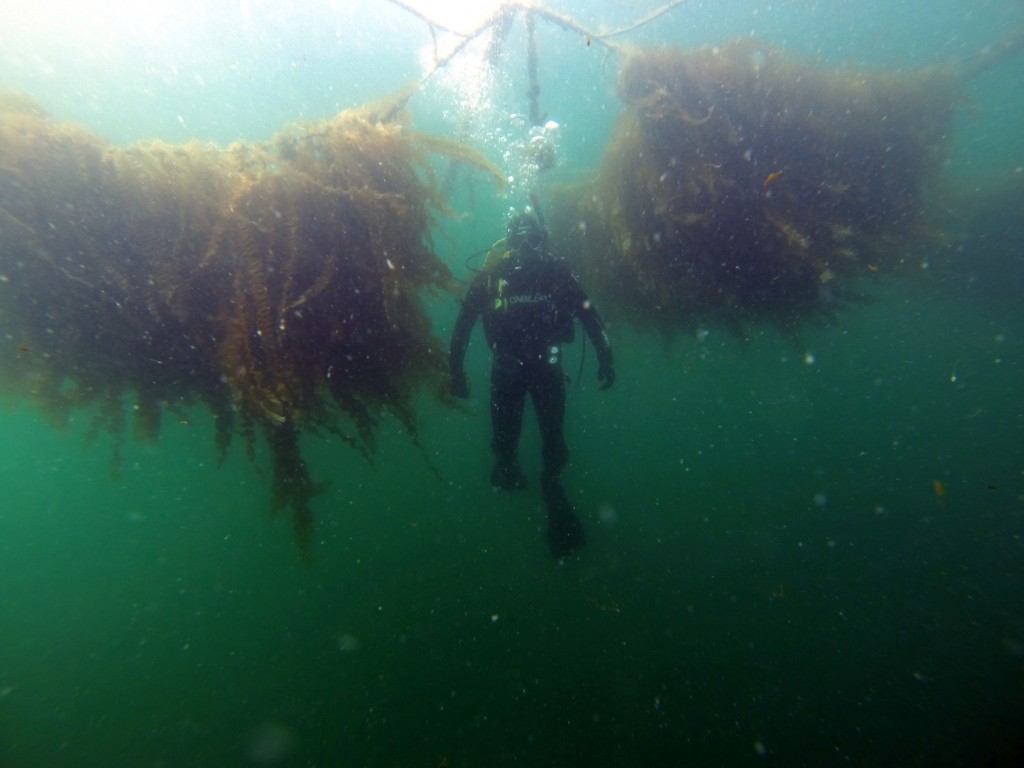New textile sheets boost yields in seaweed farming.

A diver inspects seaweed growing at AT~SEA’s test site near Galway, Ireland.
Seaweed, it is believed, is an important but under-exploited resource for food and feed ingredients, biochemicals and the production of biofuels. However, it has been difficult to harvest efficiently on a large scale.
The European Union-funded AT~SEA project is addressing this challenge and has developed advanced textiles that give high yields from floating seaweed farms and allow easy, mechanized cultivation. According to information released by the European Commission, Brussels, tests of AT~SEA’s textiles at trial sites in Solund, Norway; Oban, Scotland; and Galway, Ireland have produced yields of up to 16 kg of wet seaweed per square meter, which is three to five times the yield of traditional seaweed farming.
Project coordinator Bert Groenendaal of Belgium-based Sioen Industries says that farming seaweed on the scale made possible by the new textiles can help create a multi-billion euro industry in Europe, with applications in food and food additives, animal feed, chemicals and fuel.
Textile mats make the difference
Typically, seaweed is obtained by harvesting wild seaweed or by rope-based cultivation. Neither of these scale up easily, as both methods are labor intensive with relatively low yields. The project team developed textiles that can support large numbers of seaweed plants without breaking up or attracting unwanted plants or mollusks. Bio-sourced coatings on the textiles protect young seaweed and boost growth.
The textiles are suitable for large, 1 mm-thin mats on which seaweed plants grow, held a couple of meters below the sea’s surface. When the seaweed is fully grown, ship-based machines cut the plants from the mats and direct them to flexible storage tanks, also made from AT~SEA’s advanced textiles.
In September, AT~SEA started cultivating 200 square meters of mats at each of the three trial sites and evaluate potential for commercial use. Groenendaal estimated that yields could increase to 20-25 kg per square meter as techniques are refined.
The AT~SEA consortium has applied for a patent on the textiles. After the project ends in
July 2015, the consortium plans to establish a 2 to 3 hectare cultivation site through a commercial company to be spun off from AT~SEA. Commercial uses for the textiles beyond seaweed cultivation could include other types of aquaculture and flexible containers for transporting fresh water by sea.

Environmental advantages
Large-scale seaweed farming could also have a positive impact on the ocean’s ecosystem.
Farmed seaweed can help absorb excess CO2 in seawater and waste nutrients from nearby fish farms and provide safe habitats for wild fish and shellfish that might otherwise be threatened by fishing.
The AT~SEA project, supported with €3.4 million in EU funding, brought together a variety of companies and research centers from Belgium, Ireland, Morocco, the Netherlands, Norway, Portugal, Spain and the U.K.
On January 1, 2014, the European Union launched a new, seven-year research and innovation funding program called Horizon 2020. Over the next seven years almost €80 billion will be invested in research and innovative projects, focused mainly on improving everyday life in health, the environment, transport, food and energy.
 TEXTILES.ORG
TEXTILES.ORG


